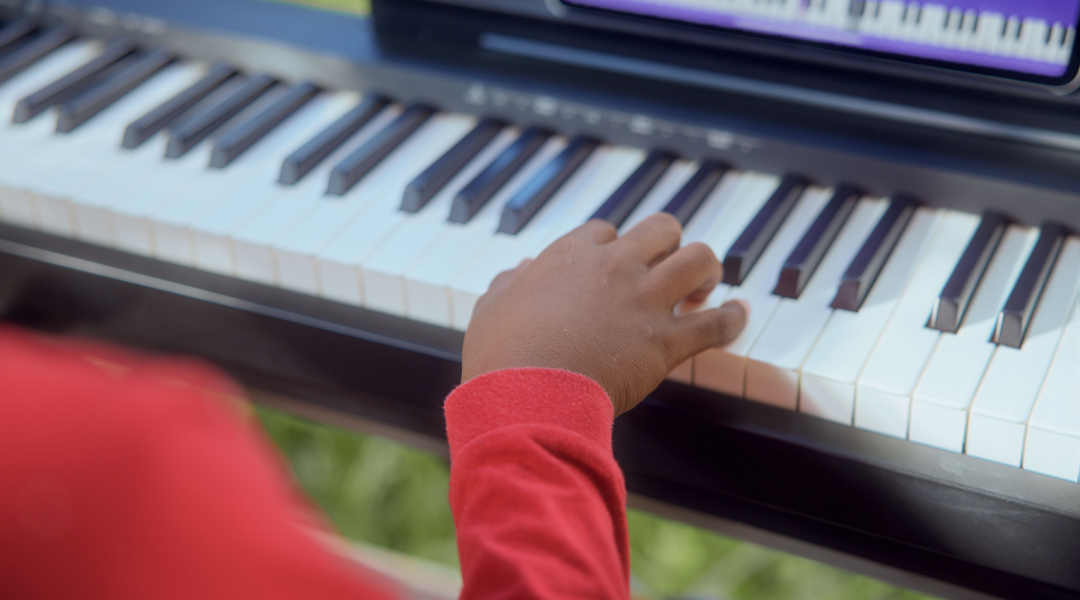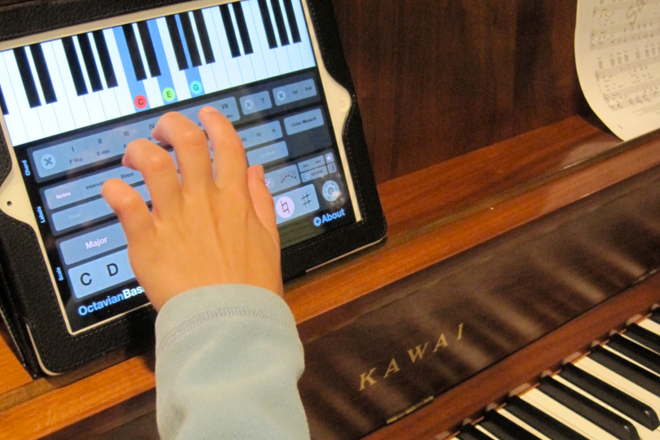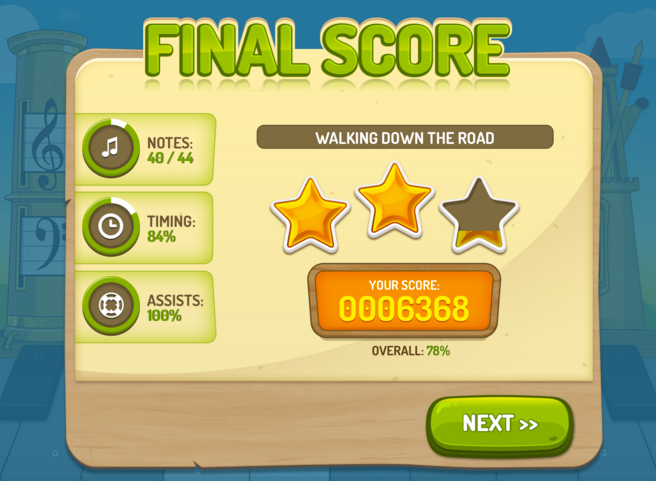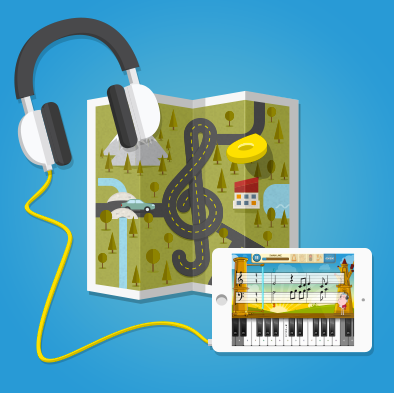How to Play Music in a 4/4 Time Signature

Do you ever wonder what the 4/4 is at the beginning of the staff? It’s the most common music time signature. Let’s see how to play music in a 4/4 time signature.
When you hear a song on the radio, your may notice an interesting melody line or latch onto an exciting beat or rhythm. Usually, you won’t stop to analyze why some melodies are more pleasing than others. But a lot of it has to do with the structure of a piece.
While a melody might seem to flow from one line to the next effortlessly, it is carefully following a set of rules.
Each note has its own beat, and each beat organizes into groups called measures. The measures set up the structure of a piece, and the time signature lets you know how many notes are allowed in one measure.
While there are many different time signatures, a 4/4 time signature is the most popular.
Let’s learn more about 4/4 time and how you play music in this time signature.
What is a 4/4 time signature?
After the treble clef symbol and bass clef symbol, you will see the key signature, then something that looks like a fraction–your time signature. It lets you know how many beats you have in a measure and how many notes you can squeeze into one measure.

The first number tells us how many beats there are in one measure of music (4). Then the second number tells us that a quarter note, ¼, gets the beat.
So if you are counting as you play (which is a good idea to keep a regular beat), you count 1-2-3-4, 1-2-3-4, and so on.
Quarter notes last one beat, half notes two beats, and whole notes hold for four beats. If you have eighth notes, you play two of them in one beat. How to notice, hear, and feel a 4/4 time signature.
Our ears are most accustomed to hearing a 4/4 time signature. So, your ear is more likely to notice a rhythm that does not sound like 4/4 time. However, this time signature sounds very stable and even since you have four beats in each measure.
Four on the floor is a common name for keeping a rhythm of four quarter notes. But, you are not limited to only quarter notes! You can use a variety of rhythms and note values as long as they add up to four quarter notes in a measure.

Use half notes, dotted half notes, sixteenth notes, or even triplets. If your note values aren’t adding up to fit into the measure, you can use a tie to connect note values across the measure line.
The more variation you use in your note values, the less you will notice the time signature of the piece.
Steps to play music on 4/4 time signature.
When you sit down to play a song on the piano, check to see what the time signature says. Is it in 4/4 time or another time signature?
If it is in 4/4 time, it is good practice to count out the beats of each measure as you learn a new piece. Try tapping out the note values on your lap before touching the keys as part of your warm-up exercises. This will give you an idea of the piece’s rhythm and help you keep the beat when you play the song on the piano.
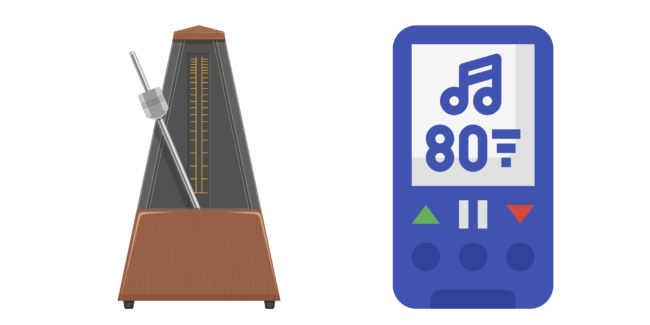
Many musicians also practice music with a metronome. You can use the Simply Piano app to set your piece’s time signature and tempo. This helps you keep a steady beat in 4/4 time. Once you hear four metronome clicks, you know that one measure is up.
What’s the difference between a 4/4 and other time signatures?
Out of all the time signatures, 4/4 time is the most common. Some people call it “common time.” Sometimes you can even see the letter C on the staff instead of the classic 4/4 symbol.
Less-common time signatures also appear at the beginning of the staff, such as 2/2, 2/4, 3/4, etc. So, how does the composer know which one to choose when writing a song? Let’s look at a few other time signatures and see what they mean.
The 2/2 time signature
The 2/2 time signature, or cut time. is sometimes notated as the letter C with a slash through it. You have two beats per measure; a half note gets the beat.
This signature is similar to 4/4 time, except you should play the notes twice as fast. This time signature is suitable for fast-paced music.
The 2/4 time signature
The 2/4 time signature or simple duple has two beats in a measure and the quarter note gets the beat. This time signature is often found in polkas, galops, or marches.
If you take two measures of the simple duple time signature, you can hear the beat as OOM, pah, OOM, pah with the accent on the first note of the measure. Or, it is sometimes played OOM pah, pah, pah with an accent on the first note of every other measure.
The 3/4 time signature
The 3/4 time signature means that you have three beats per measure and the quarter note gets the beat. This time signature sounds light and lilting and is also known as the waltz beat. Generally, you accent the first note slightly and play the two following notes a bit softer. This matches the down, up, up waltz step dancers use as they glide across the floor.
The 2/2, 2/4, and 3/4 time signatures come up often in pieces but are not as common as the 4/4 time signature. There are also many other time signatures out there. Some like the 5/8, 5/4, and 7/4, and others are so irregular that they get very little use.
To count out any measure with any time signature, remember these facts:
- The fraction symbol’s top number (the numerator position) tells you how many beats will be in a measure.
- The bottom number (in the denominator position) tells you what note value gets one beat.
Now you are ready to keep up with those rhythms!
Popular songs that have 4/4 time signature
Since a 4/4 time signature is the most popular, you will hear this beat in most mainstream songs. Some examples of songs that keep the 4/4 rhythm are Sweet Child O’ Mine, Photograph by Ed Sheeran, We Will Rock You by Queen,
Seven Nation Army by The White Stripes, and Firework by Katy Perry. The 4/4 time signature is prevalent in pop, rock, blues, funk, and country music genres.
You, too, can get with the beat!
When you begin to read music, you’ll notice a lot of information packed into just the first line of the piece. You’ll see markings for the clef, key signature, tempo, and time signature. At first glance, the symbols and instructions on playing your piece can be a bit overwhelming. But as you slowly begin to break down what each means, reading these signs and symbols will become second nature.
The Simply Piano app can give you feedback in real-time to make your learning the piano less tricky and more fun–we can help you get with the beat!






